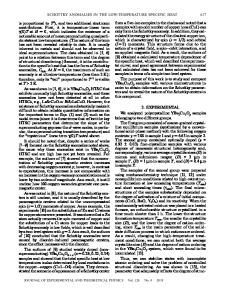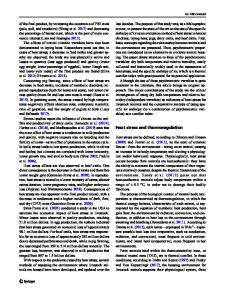Specific Heat in the Pu-Am system
- PDF / 219,443 Bytes
- 6 Pages / 612 x 792 pts (letter) Page_size
- 54 Downloads / 520 Views
0986-OO04-02
Specific Heat in the Pu-Am System Ladislav Havela1, Pavel Javorský1, Alexander Shick2, Franck Wastin3, and Eric Colineau3 1 Department of Condensed Matter Physics, Charles University, Faculty of Mathematics and Physics, Ke Karlovu 5, Prague 2, CZ-12116, Czech Republic 2 Institute of Physics, Academy of Sciences of the Czech Republic, Na Slovance 2, Prague 8, CZ18221, Czech Republic 3 European Commission, Joint Research Centre, Institute for Transuranium Elements, Postfach 2340, Karlsruhe, D-76125, Germany
ABSTRACT Specific heat of Pu doped with Am was studied for several Am concentrations (8-20%) ensuring the δ-Pu fcc structure. The results reveal that the γ-value of the low temperature specific heat is lower than originally assumed (γ ≈ 35 - 55 mJ/mol K2 can be deduced for Pu-8%Am) and does not increase with the Am-induced lattice expansion. The findings can be taken as an indication of the absence of the Pu-5f states at the Fermi level.
INTRODUCTION In the effort to reveal details of enigmatic electronic structure of δ-Pu, specific heat data, can have invaluable importance, being a sensitive indicator of the density of quasiparticle states in narrow-band systems. At temperatures T < ΘD/10, where ΘD is the Debye temperature, its temperature dependence can be typically approximated as C = γT + βT 3, the first term being due to the electronic specific heat, the second due to phonons. The parameter “γ“ indicates the quasiparticle density of states, and decreases dramatically if the f- states localize (as in Am with γ = 2 mJ/mol K2 [1]). On the other hand it also decreases with broadening the 5f band due to enhanced delocalization, as in Np (14 mJ/mol K2) [2] or U (10 mJ/mol K2) [3]. In extreme cases, several Ce or U-based heavy fermions, values over 1000 mJ/mol K2 were recorded [4]. As to pure Pu, low temperature experiments cannot be performed for the large-volume fcc δ-Pu phase, which is stable only at 592-724 K, and eventually collapses into a low-volume monoclinic α-Pu phase upon cooling. Existing specific heat data were collected for the α-phase (γ = 17 mJ/mol K2 in the most recent work [5], which discusses also older data) and for δ-Pu, stabilized by several at.% of Al [5,6]. Unfortunately, as illustrated also in Ref. 5, the Al-doped fcc systems are in fact metastable, Al-rich areas are formed and the Al-poor Pu undergoes at low T a martensitic transition to a monoclinic phase, which is analogous to α-Pu and is denoted as α’. Besides studying a biphasic material, the anomaly related to the transition can hide the intrinsic specific heat behavior of δ−Pu. Nevertheless, the γ-values, namely (53±10) mJ/mol K2 [6] or (64±3) mJ/mol K2 [5], are substantially higher than for α-Pu. The only “reliable” dopant, safely eliminating the transformation to the monoclinic phase, is Am, probably because it also expands
the lattice more than any other element. The volume increase reaches 3.5% for 20% Am compared to the value extrapolated for 0% Am [7]. Specific heat measurements on δ-Pu stabilized by various con
Data Loading...











